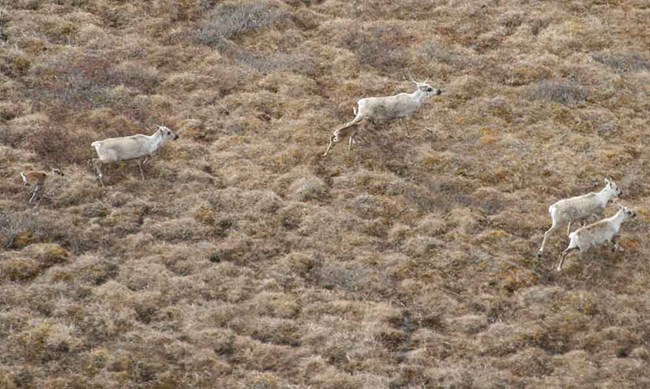Last updated: November 12, 2020
Article
Timing of caribou calving in Canada is responding to climate change

NPS/Kyle Joly
Using a new animal movement archive for the Arctic, a large group of international researchers (including some from the National Park Service in Alaska) analyzed the timing of caribou calving in central Canada’s Arctic. Locations and movement patterns collected from GPS collars were used to determine caribou calving locations. The researchers determined the location and date of over 1,600 calving events and discovered that populations of barren-ground migratory and northern mountain woodland caribou were calving early as their climate warmed. Trends were not apparent for other types of caribou.
Earlier calving may be beneficial if caribou can use the high-quality forage that comes with the first flush of green to the north in early summer, which has also been coming earlier, to regain body stores lost over the winter and to meet the energetic demands that come with nursing calves. Both latitude and elevation appear to influence the timing of calving, with calving occurring later at more northernly locations and higher elevations. Barren-ground caribou calve the latest of all the types of caribou that were analyzed.
Ecological Insights from Three Decades of Animal Movement Tracking Across a Changing Arctic
Abstract
The Arctic is entering a new ecological state, with alarming consequences for humanity. Animal-borne sensors offer a window into these changes. Although substantial animal tracking data from the Arctic and subarctic exist, most are difficult to discover and access. Here, we present the new Arctic Animal Movement Archive (AAMA), a growing collection of more than 200 standardized terrestrial and marine animal tracking studies from 1991 to the present. The AAMA supports public data discovery, preserves fundamental baseline data for the future, and facilitates efficient, collaborative data analysis. With AAMA-based case studies, we document climatic influences on the migration phenology of eagles, geographic differences in the adaptive response of caribou reproductive phenology to climate change, and species-specific changes in terrestrial mammal movement rates in response to increasing temperature.
Davidson, S. C., G. Bohrer, E. Gurarie, S. LaPoint, P. J. Mahoney, ... K. Joly, ... J. P. Lawler, ...B. Mangipane, ... C. L. McIntyre, ... P. A. Owen, ... M. S. Sorum, ... et al. 2020. Ecological insights from three decades of animal movement tracking across a changing Arctic. Science 370(6517): 712-715.
Also see:
Arctic Archive of Animal Migration
